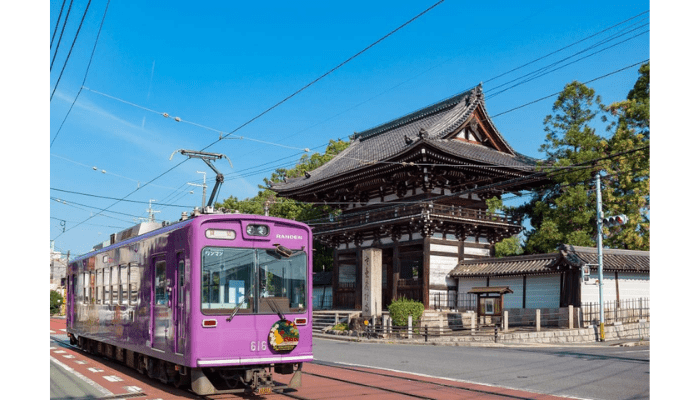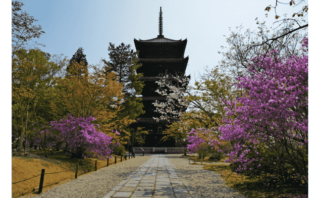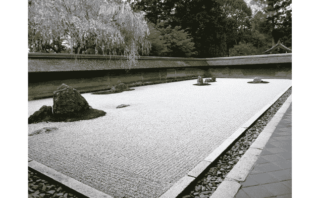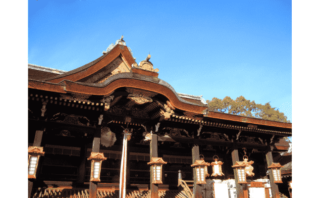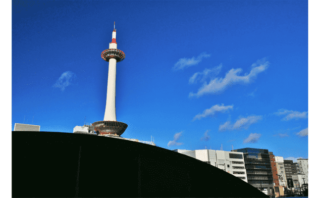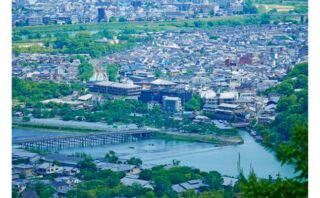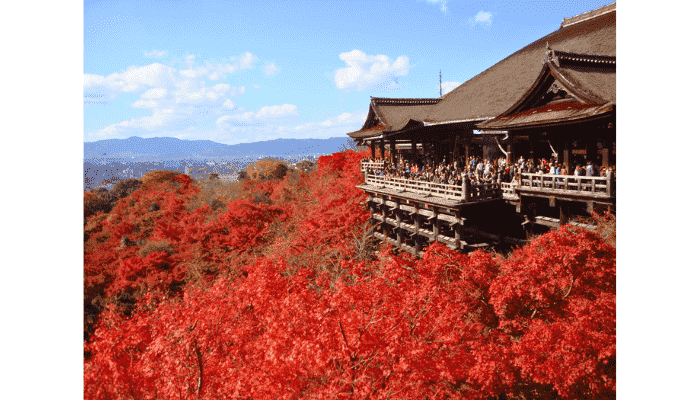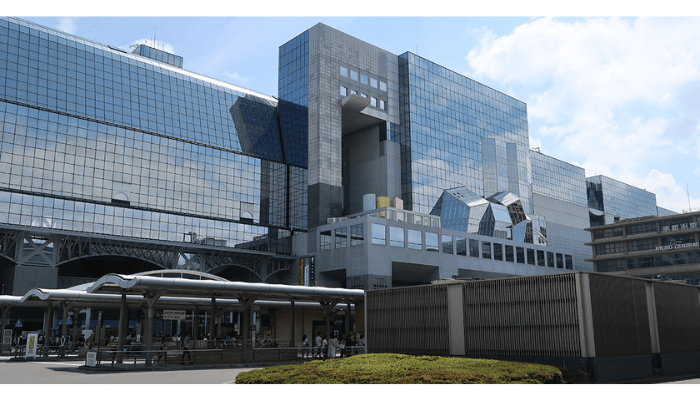Kyoto is a city loved by people from all over the world. It’s the kind of place you’ll want to visit not just once or twice, but again and again.
With famous attractions scattered across almost every corner of the city, there’s always something new to discover each time you visit.
While tourist buses and trains are convenient ways to get around, did you know that Kyoto also has a charming local tram called “Randen”? This nostalgic streetcar is still used daily by locals and offers a unique way to experience Kyoto’s old-fashioned charm.
Imagine traveling between historic temples and shrines on a quaint tram—it’s an experience full of Kyoto’s timeless beauty.
In this article, we’ll introduce a new way to enjoy Kyoto: exploring the city’s attractions by riding the Randen tram!
What is the Randen Tram?
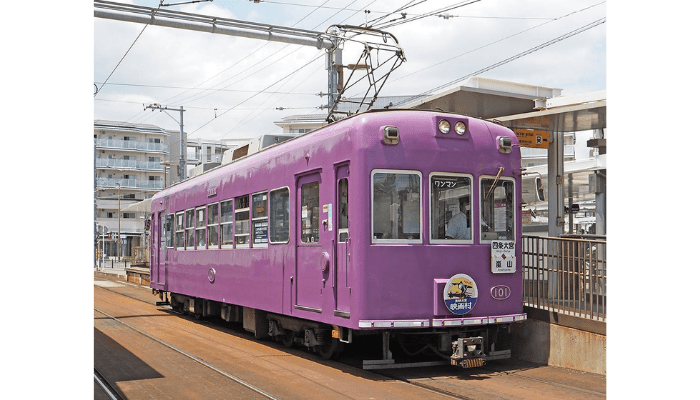
The “Randen” is a charming streetcar operated by Keifuku Electric Railroad. Loved by locals for decades, it serves as an essential mode of transportation in Kyoto.
The Randen has two lines: the Kitano Line and the Arashiyama Line. Its name comes from shortening “Keifuku Electric Railroad Arashiyama Line” to simply “Randen.”
Interestingly, this historic tram first began operating in 1910, during Japan’s Meiji era. With such a long history, it’s no exaggeration to say the Randen has witnessed Kyoto’s evolution over the years.
The Randen is both a convenient sightseeing route to popular spots in the Rakusai (Western Kyoto) area, including Arashiyama, and a daily commuter line connecting to Shijo Street, a bustling shopping and entertainment district.
Because the tracks run through residential areas, most of its passengers are local residents.
In terms of atmosphere, the Randen is often compared to the Enoden (Enoshima Electric Railway) in Kamakura. In fact, the two trams established a sister relationship in 2009.
Randen’s official mascot, “Aran,” is inspired by the vibrant autumn colors of Arashiyama. Aran helps promote the Randen to both locals and tourists.
Typically, the Randen operates with a single car and a single driver. However, during rush hours or busy tourist seasons, it switches to a two-car setup to accommodate more passengers.
Tips to Know Before Riding the Randen Tram
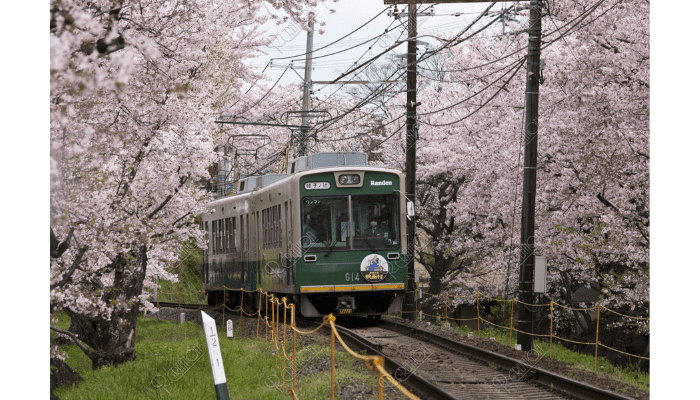
If you’ve visited Kyoto before but never ridden the Randen tram, you’re not alone! For first-timers, here are some handy tips to make your experience smooth and enjoyable.
1. How to Ride the Randen Tram
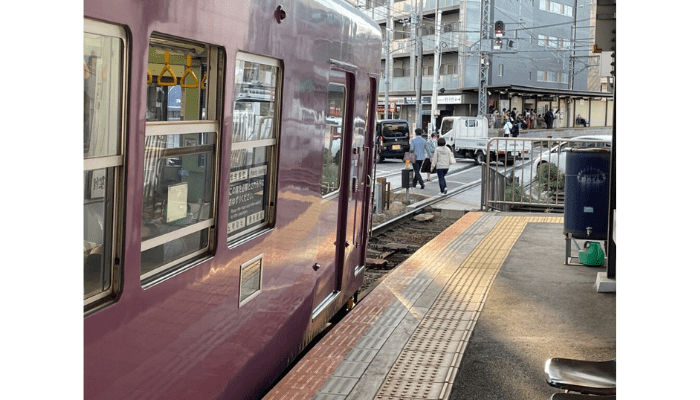
If you’re not familiar with streetcars, you might feel a little unsure about how to get on and off. But don’t worry—it’s easy once you know the basics!
Transfers at Katabiranotsuji
If you need to transfer to another Randen line at Katabiranotsuji Station, you don’t need to pay when you get off. Simply transfer to the next tram, and pay at your final destination.
Flat Fare System
The fare is simple and uniform: 220 yen for adults and 110 yen for children, no matter where you get on or off.
You pay when you get off, using the fare box near the front door next to the driver. If you’re using an IC card, tap it only when you exit.
Station Payment Exceptions
At some stations—Shijo-Omiya, Katabiranotsuji, Arashiyama, and Kitano-Hakubaicho—you pay at the station gate, not on the tram. Keep this in mind to avoid confusion.
Two-Car Trams
During rush hours, the Randen runs with two cars. Note that you can’t move between the cars, so if you’re in the second car, pay your fare to the crew member at the front of that car when you get off.
2. Save Money with Randen Free Passes
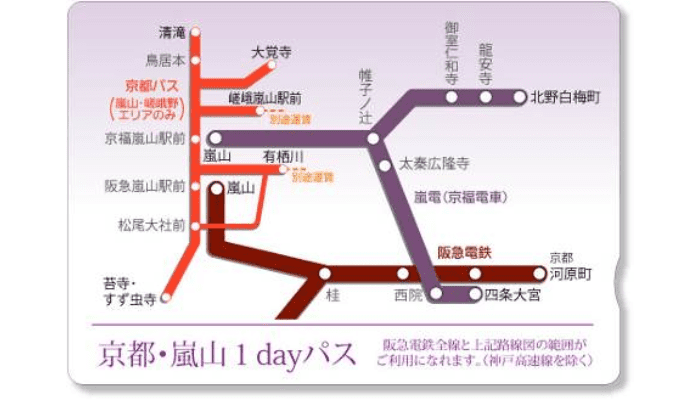
Make your Kyoto sightseeing more affordable and convenient with special passes for the Randen tram!
Kyoto-Arashiyama 1-Day Pass
This seasonal pass is available during the spring and autumn months for just 1,300 yen for adults. You can purchase it at any Hankyu Railway station or the four major Randen stations: Shijo-Omiya, Katabiranotsuji, Arashiyama, and Kitano-Hakubaicho.
With this pass, you can enjoy unlimited rides on all Randen tram lines and Kyoto Bus routes in the Arashiyama and Sagano areas. It also comes with discount coupons for attractions and small gifts at select locations, adding even more value to your trip.
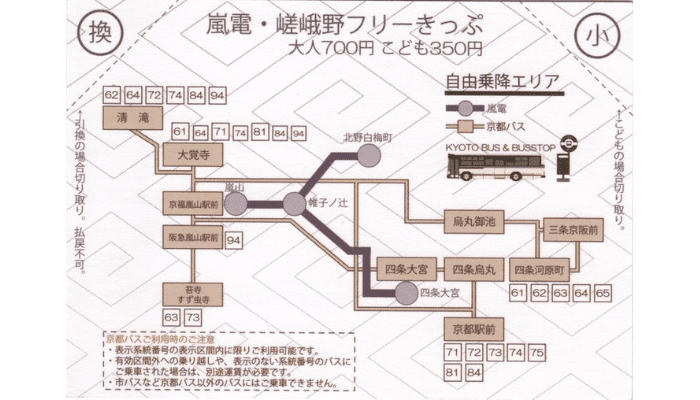
Randen-Sagano Free Pass
If you’re visiting outside the spring and autumn seasons, the Randen-Sagano Free Pass is available year-round for only 800 yen for adults. It offers unlimited rides on the Randen tram, covering key spots like North Sagano (home to Adashino Nenbutsu-ji and Daikaku-ji) and the southern area of Arashiyama, including Suzumushi-dera Temple.
This pass also comes with perks like discounts at temples and shrines along the Randen line and small gifts at select locations. It’s an affordable and convenient option for exploring the Randen tram area!
3. Store Your Luggage in Lockers
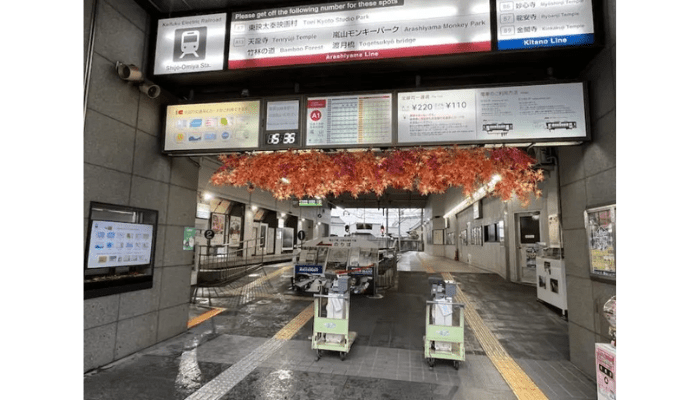
Carrying a suitcase while sightseeing can be inconvenient, right?
Randen provides coin lockers at Arashiyama, Kitano-Hakubaicho, and Shijo-Omiya stations.
Lockers are not available at other stations, so be sure to store your luggage at one of these three locations before exploring.
4. Perfect for Cherry Blossom Season!
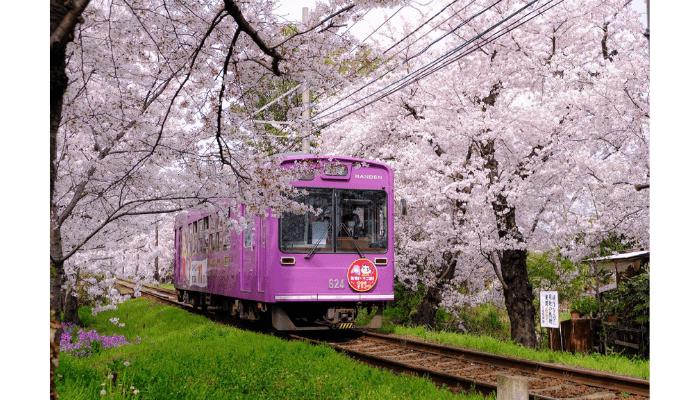
While you can enjoy cherry blossoms at nearby temples and shrines after getting off the Randen, the train itself offers a unique way to experience the beauty of the season.
Between Narutaki Station and Utano Station on the Kitano Line, there’s a 200-meter stretch known as the “Cherry Blossom Tunnel,” where the tracks are lined with gorgeous cherry trees. The soft pink hues of the blooming Somei Yoshino cherry blossoms outside the train windows create a warm, heartwarming atmosphere.
During the cherry blossom season, a special Night Sakura Train runs for a limited time, allowing you to enjoy illuminated cherry blossoms from the comfort of your seat—a completely different experience from daytime viewing.
Additionally, during spring and autumn sightseeing seasons, special direct trains may run on weekends and holidays, connecting Kitano-Hakubaicho Station, Katabiranotsuji Station, and Arashiyama Station.
Enjoy Fun Collaborations!
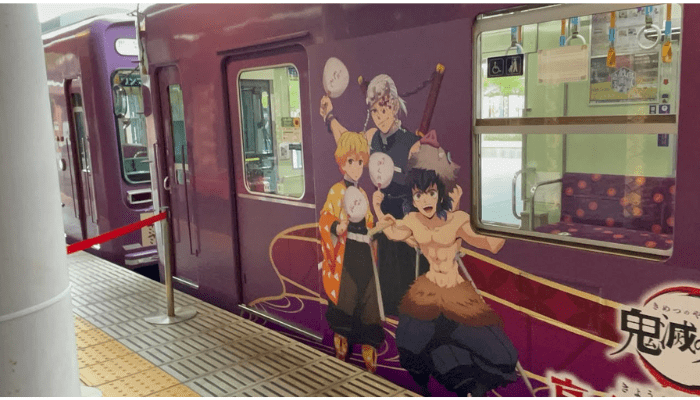
Randen frequently collaborates with popular TV anime and well-loved characters, making the ride even more exciting.
In the past, there have been collaborations with hit series like Evangelion, the popular otome game Hakuouki, and even Peko-chan. These special trains are wrapped with designs featuring the characters, offering a fun experience whether you’re riding them or just watching them go by.
Since these collaborations are only available for a limited time, it’s a rare chance to see them. If your favorite character makes an appearance, don’t miss the opportunity to check it out!
Recommended Spots Along the Randen Line!

The Randen Line has 22 stations across the Arashiyama Main Line and the Kitano Line, with historical landmarks and attractions near almost every stop.
With so many incredible spots to visit, it can be hard to decide where to go.
Here, we’ll introduce must-see attractions along the Randen Line to make your journey unforgettable. Enjoy a unique Kyoto experience centered around the Randen!
1. Tenryu-ji Temple

Tenryu-ji Temple was founded in 1339 during the Nanboku-cho period by Ashikaga Takauji to honor Emperor Go-Daigo’s spirit. The temple’s name is said to have come from a story where Takauji’s brother, Tadayoshi, saw a dragon ascending from a river to the heavens.
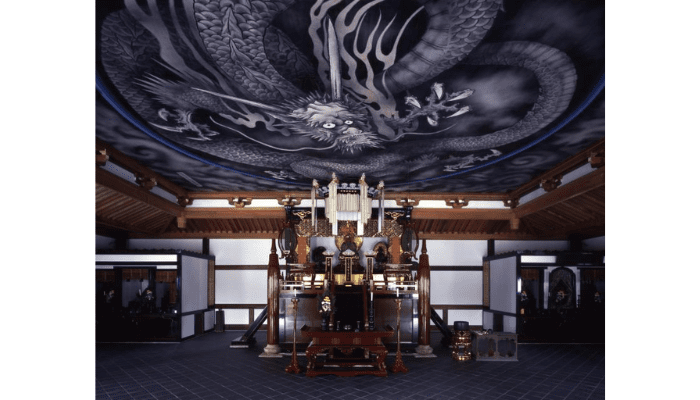
As a Zen temple with many dragon-related connections, its Unryu-zu (Cloud Dragon Painting) in the Dharma Hall is particularly famous. Originally painted by artist Suzuki Shonen in 1864, it was later replaced in 1997 with a new rendition by renowned contemporary artist Kayama Matazo, commemorating the temple’s 650th anniversary.
This stunning artwork features a dynamic dragon with long horns, sharp claws, and detailed scales. Its powerful, twisting body looks almost alive, all depicted using just shades of indigo and navy blue. The dragon’s eyes are particularly striking—they seem to follow you no matter where you stand, adding a mysterious touch.
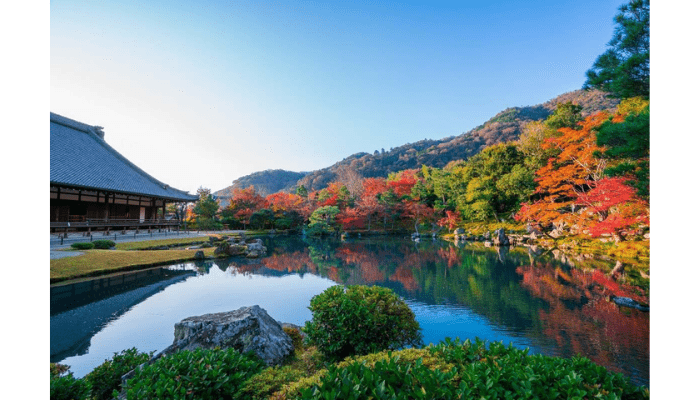
Another highlight is the Sogenchi Garden, a Special Place of Scenic Beauty and UNESCO World Heritage Site. Designed by Muso Soseki, the garden was the first in Japan to be designated as both a historic site and a place of scenic beauty. It retains much of its original appearance from the temple’s founding.
The garden is designed to be admired from any spot within the temple’s Hojo (main hall), offering breathtaking views year-round. Whether you visit in spring, summer, autumn, or winter, you’ll be captivated by the harmony of nature and artistry.
Take a moment to sit on the temple’s veranda and immerse yourself in the tranquil beauty, letting go of the stresses of daily life.
Tenryu-ji Visitor Information
- Address: 68 Saga Tenryuji Susukinobabacho, Ukyo Ward, Kyoto City, Kyoto Prefecture
- Map: Google Maps
- Access: A short walk from Randen Arashiyama Station
- Phone: 075-881-1235
- Hours: 8:30 AM – 5:00 PM
- Admission Fees:
- Garden (Sogenchi and Hyakka-en): 500 yen (high school and above), 300 yen (elementary/middle school)
- Temple buildings (Hojo, Shoin, Tahoden): Additional 300 yen with garden ticket
- Dharma Hall “Unryu-zu” special viewing: 500 yen per person
- Official Website: Tenryu-ji Temple
2. Kurumazaki Shrine

Kurumazaki Shrine, located in Sagano, is well-known as a shrine for performers and entertainers. Many people from the entertainment industry have visited to pray here.
In addition to blessings for academic success and passing exams, the shrine is also famous for its divine power to protect promises. It is believed to ensure that agreements in business, marriage vows, or any kind of commitment are upheld, making it a versatile shrine for various wishes.
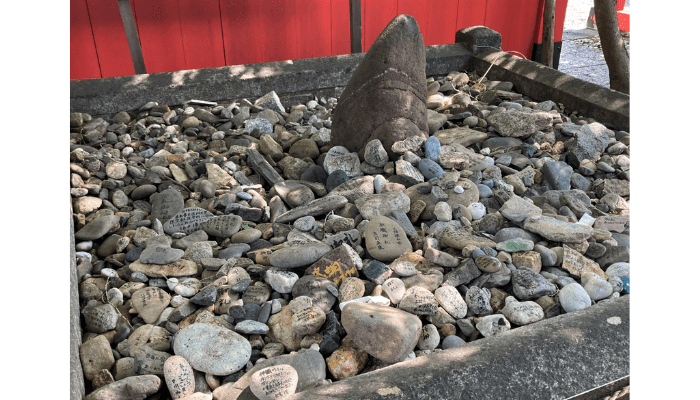
The Special Ritual of the “Kinen Shinseki” (Sacred Stone)
One of the highlights of visiting Kurumazaki Shrine is the ritual involving the “Kinen Shinseki” (Sacred Stone). Visitors receive a stone from the shrine office, hold it tightly, and make a heartfelt wish in front of the main hall. Afterward, they carry the stone with them at all times.
Once their wish is granted, they write a message of gratitude on a stone they find in nature, such as by a river or the sea, and return both the sacred stone and the gratitude stone to the shrine.
This unique custom might seem mysterious, but the shrine grounds are filled with stones bearing messages of thanks, a testament to the many fulfilled wishes.

A Shrine Loved by the Entertainment Industry
The shrine is also famous for its tamagaki (votive plaques) donated by members of the entertainment industry. These bright red plaques line the shrine grounds, creating a vivid and celebratory atmosphere.
There are said to be around 2,000 tamagaki in total, making it fun for visitors to search for plaques from their favorite artists or performers.
Kurumazaki Shrine Visitor Information
- Address: 23 Saga Asahi-cho, Ukyo Ward, Kyoto City, Kyoto Prefecture
- Map: Google Maps
- Access: A short walk from Kurumazaki Shrine Station on the Randen Line
- Phone: 075-861-0039
- Hours: 9:00 AM – 5:00 PM
- Official Website: Kurumazaki Shrine
3. Koryu-ji Temple
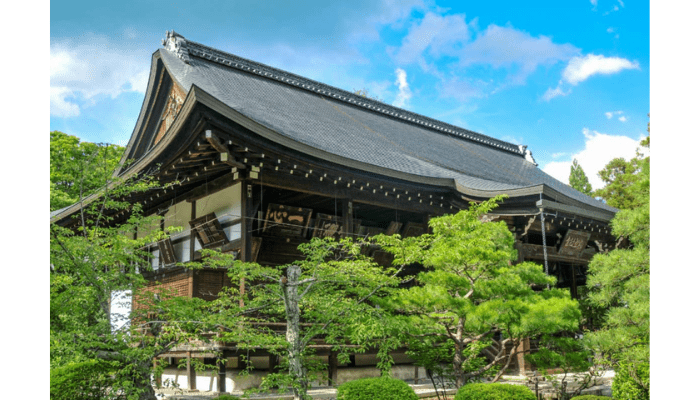
Koryu-ji Temple was established in 603 by Hata no Kawakatsu, a close follower of Prince Shotoku. The temple was built to enshrine a statue of Buddha gifted to him by the prince.
Remarkably, Koryu-ji is said to be the oldest temple in Kyoto, a city filled with countless historic temples and shrines.
The Legacy of Hata no Kawakatsu
Hata no Kawakatsu is believed to have been of Chinese descent, later naturalizing in Japan. He introduced many advanced skills and knowledge to Japan, including techniques in civil engineering, agriculture, sake brewing, silk production, and water management.
As a trusted ally of Prince Shotoku, Hata no Kawakatsu played a significant role in shaping early Japanese culture and technology.
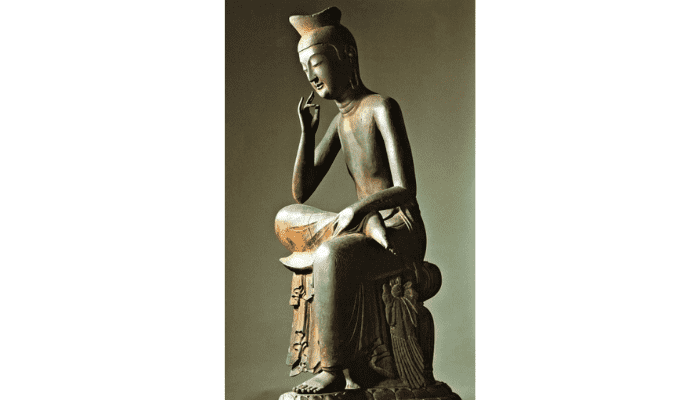
A Treasure of Buddhist Art
Koryu-ji is home to Japan’s first officially designated National Treasure, the “Miroku Bosatsu Hankashi Yui Zo” (Maitreya Bodhisattva in a Half-lotus Pose).
This statue, often regarded as Japan’s most beautiful Buddhist sculpture, is mesmerizing. The serene expression, with the right hand gently touching the cheek, carries an aura of timeless grace that can leave visitors captivated for hours.
In addition to this iconic statue, the temple houses 17 other National Treasure statues and numerous Important Cultural Properties, making it feel like a museum of Buddhist art.
Surviving Two Major Fires
Koryu-ji has faced two devastating fires in its long history. The first occurred in 818, and the second in 1150.
While much of the original structures and materials were lost in these fires, the temple was rebuilt relatively quickly each time. By 1165, the reconstruction was complete, and a dedication ceremony was held.
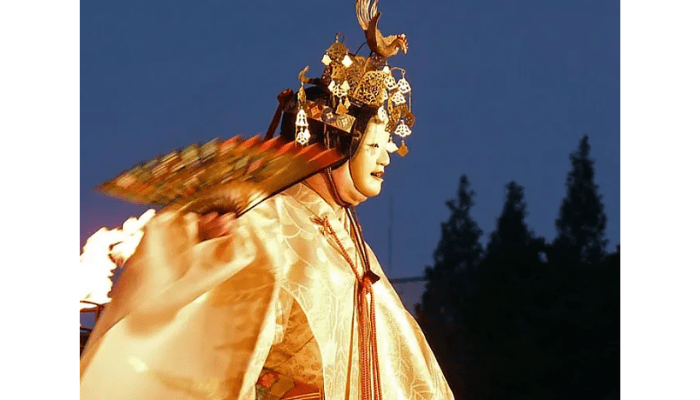
The Unique “Ushi Matsuri” (Ox Festival)
In October, Koryu-ji hosts the “Ushi Matsuri,” one of Kyoto’s three most unusual festivals. During the event, a deity dressed in a mask and elaborate decorations rides an ox around the temple grounds, accompanied by attendants portraying the Four Heavenly Kings as red and blue demons.
If you’re visiting Kyoto in October, this fascinating festival is worth experiencing!
Koryu-ji Temple Visitor Information
- Address: 32 Uzumasa Hachioka-cho, Ukyo Ward, Kyoto City, Kyoto Prefecture
- Map: Google Maps
- Access: A 3-minute walk from Uzumasa Koryu-ji Station on the Randen Line
- Phone: 075-861-1461
- Hours:
- March–November: 9:00 AM – 5:00 PM
- December–February: 9:00 AM – 4:30 PM
- Admission:
- Adults: 800 yen
- High school students: 500 yen
- Elementary and middle school students: 400 yen
- Official Website: Koryu-ji Temple
Ninna-ji Temple
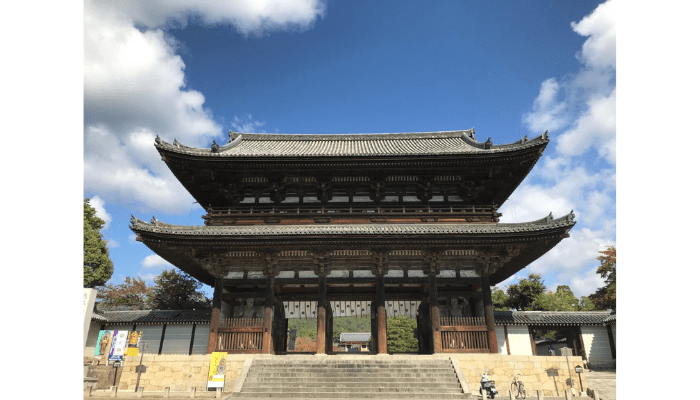
Ninna-ji Temple, a historic site in Kyoto, was founded in 888 by Emperor Kōkō, the 58th Emperor of Japan. In 1994, it was designated a UNESCO World Heritage Site, adding another chapter to its rich history.
At the temple’s entrance, you’ll find the imposing Nio-mon Gate, a large gate flanked by statues of the fearsome Nio guardians. This gate is one of Kyoto’s Three Great Gates.

Once you step inside, you’ll be greeted by a sprawling temple complex featuring many important cultural properties. Highlights include the Kondo (Main Hall), a national treasure, as well as the Five-story Pagoda, Mieido Hall, and Kannon-do Hall, all built during the Edo period. The temple’s architecture reflects the elegant style of the imperial palace, showcasing its deep connections to the royal family and aristocracy.
Despite its grandeur, Ninna-ji has faced challenges. During the Ōnin War (1467–1477), much of the temple was destroyed. However, about 160 years later, many structures were rebuilt with materials transferred from the Imperial Palace, restoring Ninna-ji to its former glory.

Omuro Sakura – A Unique Cherry Blossom Experience
Ninna-ji is also famous for its cherry blossoms, attracting visitors from all over. Among its many varieties, the Omuro Sakura stands out. These late-blooming cherry trees are short, standing only 2–3 meters tall, but they create a breathtaking view when in full bloom, forming a pink forest-like landscape.
Omuro Sakura has been beloved by locals since the Edo period and is often featured in traditional Japanese poetry. One famous haiku by Yosa Buson reads:
“Spring drowsiness—
even the flowers of Omuro
seem to feel it.”
The best time to see the Omuro Sakura is mid-April. The trees bloom with the same beauty they have shown for centuries, making it a timeless experience.
Ninna-ji Temple Visitor Information
- Address: 33 Omuro Ouchi, Ukyo-ku, Kyoto
- Map: Google Map
- Access: A 3-minute walk from Omuro-Ninna-ji Station on the Randen Line
- Phone: 075-461-1155
- Hours:
- March–November: 9:00 AM–5:30 PM
- December–February: 9:00 AM–5:00 PM
- Admission Fee:
- Adults: ¥500
- High school students: ¥500
- Elementary and middle school students: ¥300
- Official Website: Ninna-ji Temple
Myoshin-ji Temple
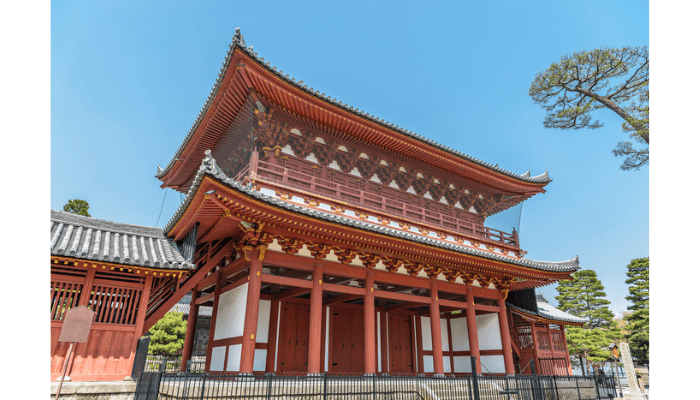
Myoshin-ji Temple, located in Kyoto, is a vast temple complex spanning 300,000 square meters. It is home to 46 sub-temples scattered throughout the grounds, creating an air of mystery and depth. However, only four of these sub-temples are open to the public year-round, making the experience of visiting Myoshin-ji all the more special.
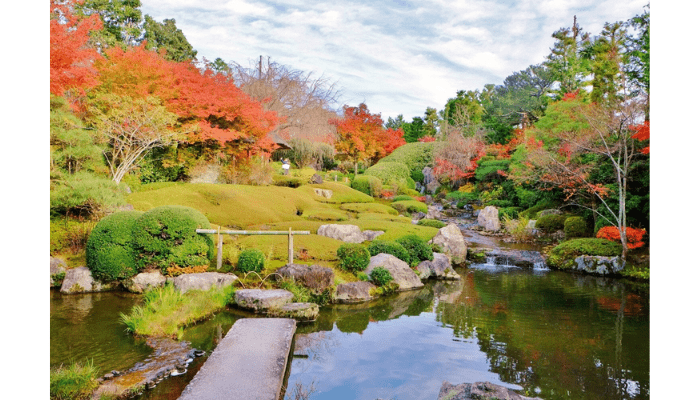
One of the must-visit sub-temples is Taizoin Temple, renowned for its stunning garden, Yoko-en. This garden, completed in 1966 after three years of meticulous work, showcases a variety of plants arranged to create a perfect harmony of colors and shapes. It is a place where you can spend hours simply admiring the beauty of nature.
While at Taizoin, take a moment to enjoy matcha (powdered green tea) at Daikyuan, a charming teahouse within the garden. The tea is served alongside a unique Japanese sweet made with mochi flour. This soft, flavorful treat features a fish-shaped stamp inspired by the famous “Catching a Catfish with a Gourd” (Hyotan Namazu) painting, which is designated as a National Treasure.
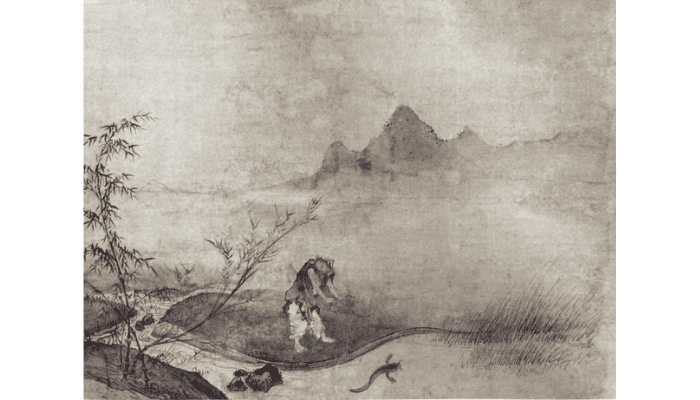
The “Catching a Catfish with a Gourd” painting is a masterpiece by Josetsu, considered the father of Japanese ink painting. Created at the request of Shogun Ashikaga Yoshimochi, this work is regarded as Josetsu’s greatest surviving piece. The painting depicts the seemingly impossible task of catching a slippery catfish with a gourd. To accompany it, Yoshimochi asked 31 Zen monks to write poems offering solutions to this riddle, sparking a unique intellectual and spiritual exercise. Imagining their creative answers adds to the charm of viewing this historical artwork.
Myoshin-ji Temple Visitor Information
- Address: 1 Hanazono Myoshinji-cho, Ukyo-ku, Kyoto
- Map: Google Map
- Access: A 3-minute walk from Myoshin-ji Station on the Randen Line
- Phone: 075-466-5381
- Hours: 9:00 AM–5:00 PM
- Admission Fee:
- Adults: ¥700
- Elementary and middle school students: ¥400
- Official Website: Myoshin-ji Temple
Toei Uzumasa Eigamura (Toei Kyoto Studio Park)

Toei Uzumasa Eigamura, located in Kyoto’s Uzumasa area, is a one-of-a-kind theme park where you can witness the filming of traditional Japanese period dramas. Opened in 1975, it was Japan’s first theme park that allowed visitors to watch behind-the-scenes filming of samurai movies and TV shows.
Since it is directly connected to the Toei Kyoto Studio, you can see actual open sets used in real TV shows and films. The park faithfully recreates buildings and landscapes from the Edo period, such as a kabuki theater (Nakamuraza), Nihonbashi Bridge, a temple school (terakoya), and a port town. Walking through these streets feels like stepping back in time to the Edo era.
The sprawling open set, roughly the size of Tokyo Dome, is often used for filming live TV and movies. If you’re lucky, you might even see a shoot happening right in front of you! Filming schedules are posted on the official website the evening before, so it’s a good idea to check in advance if you’d like to catch a live shoot.
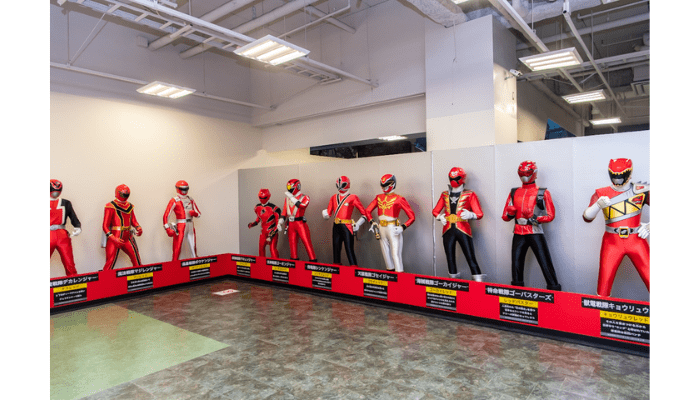
Unique Experiences and Attractions
Beyond the sets, the park offers exciting attractions and events that immerse visitors in the world of period dramas and Japanese superheroes.
One of the most popular attractions is the Super Sentai × Kamen Rider Hero Land, a dream space where you can experience the world of Toei’s iconic tokusatsu heroes. On weekends, character shows featuring Super Sentai and Kamen Rider heroes are held, with opportunities to meet the characters in person at handshake events. These professional shows, which are only possible at Toei Studio Park, are sure to excite children and fans alike.

Visitors can also dress up in authentic costumes from period dramas, such as samurai, ninja, or princess attire. After transforming, you can take photos in the real film sets, making for an unforgettable experience in the world of historical Japan.
Toei Uzumasa Eigamura Visitor Information
- Address: 10 Higashi-Hontsubo-cho, Uzumasa, Ukyo-ku, Kyoto
- Map: Google Map
- Access: A 5-minute walk from Uzumasa-Koryuji Station on the Randen Line
- Phone: 0570-064349
- Hours: 10:00 AM–5:00 PM
- Admission Fee:
- Adults: ¥2,400
- Middle and high school students: ¥1,400
- Children: ¥1,200
- Official Website: Toei Uzumasa Eigamura
Ryoan-ji Temple

Ryoan-ji, known as the “Stone Garden,” is a Zen temple founded in 1450 by Katsumoto Hosokawa, a powerful figure in the Muromachi Shogunate.
This temple gained worldwide fame thanks to an unexpected connection: Queen Elizabeth II. During her official visit to Japan in 1975, the Queen specifically requested to see the Stone Garden. She was so impressed by its beauty that her admiration was widely reported in international media, contributing to the global recognition of Ryoan-ji, especially during the Zen boom of the time.
Today, the garden, often referred to as a “rock garden,” is considered one of the most famous Japanese gardens in the world.
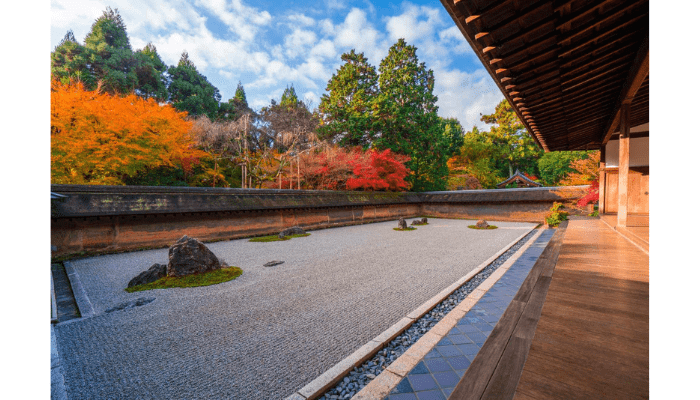
The Mysterious Beauty of the Stone Garden
Ryoan-ji’s Stone Garden is a masterpiece of simplicity and serenity. It incorporates design elements such as the golden ratio and perspective, often associated with Western art, creating a harmonious and captivating view. Just gazing at the garden can make visitors lose track of time.
However, the garden’s origins are shrouded in mystery. The exact date of its creation, its designer, and the intended meaning behind the arrangement of the rocks remain unknown. This air of mystery adds to its allure, inviting endless interpretations and enhancing its spiritual beauty.

Other Highlights: The Tsukubai Water Basin
Another must-see at Ryoan-ji is the Tsukubai, a stone water basin known as Chisoku no Tsukubai. It is said to have been donated by Tokugawa Mitsukuni, a famous historical figure also known as “Mito Komon.”
The tsukubai was traditionally used for cleansing one’s hands and mouth before entering a tea room. This particular basin is inscribed with four kanji characters arranged around the central square, which represents the word “kuchi” (mouth). Together, the inscription reads “吾唯足知” (ware tada taru wo shiru), meaning “I am content with what I have.” This reflects the Buddhist teaching that true happiness comes from knowing one’s needs and finding satisfaction in them, rather than constantly seeking more.
Ryoan-ji Visitor Information
- Address: Goryonoshita-cho, Ukyo-ku, Kyoto
- Map: Google Map
- Access: A 7-minute walk from Ryoanji Station on the Randen Line
- Phone: 075-463-2216
- Hours:
- March 1–November 30: 8:00 AM–5:00 PM
- December 1–End of February: 8:00 AM–4:30 PM
- Admission Fee:
- Adults and high school students: ¥500
- Elementary and junior high school students: ¥300
- Official Website: Ryoan-ji Temple
Kitano Tenmangu Shrine

Kitano Tenmangu, affectionately called Tenjin-san, is a shrine dedicated to Sugawara no Michizane, the deity of learning and scholarship. It is also the head shrine of over 12,000 Tenmangu and Tenjin shrines across Japan.

Highlights of Kitano Tenmangu
1. Beautiful Plum Blossoms
The shrine is famous for its connection to plum blossoms (ume), as Michizane loved these flowers. About 1,500 plum trees are planted on the shrine grounds, blooming magnificently from early February to late March. On sunny days, the contrast between the bright pink flowers and the blue sky is breathtaking.
2. Stunning Maple Leaves
Kitano Tenmangu is also a popular spot for viewing green maple leaves in summer and vibrant autumn colors. From early November to early December, approximately 350 maple trees paint the grounds in shades of red and orange. The shrine’s famous sanmata no momiji (a 350-400-year-old triple-trunk maple tree) is a must-see.

3. Monthly Tenjin Market
On the 25th of every month, the shrine hosts the lively Tenjin Market. This event offers much more than just worship, with stalls selling antiques, handmade crafts, and food, making it a unique experience for visitors.
4. Local Specialty: Awamochi
Just across from Kitano Tenmangu, you’ll find Awamochidokoro Sawaya, a traditional shop with a history of over 330 years. Their signature awamochi (millet rice cakes) is said to have originated at Kitano Tenmangu itself. The combination of lightly sweet red bean paste and fragrant roasted soybean flour creates a delicate and satisfying flavor.
Kitano Tenmangu Visitor Information
- Address: Bakuro-cho, Kamigyo-ku, Kyoto
- Map: Google Map
- Access: A 5-minute walk from Kitano-Hakubaicho Station on the Randen Line
- Phone: 075-461-0005
- Hours:
- April–September: 5:00 AM–6:00 PM
- October–March: 5:00 AM–5:30 PM
- Official Website: Kitano Tenmangu Shrine
Mibudera Temple
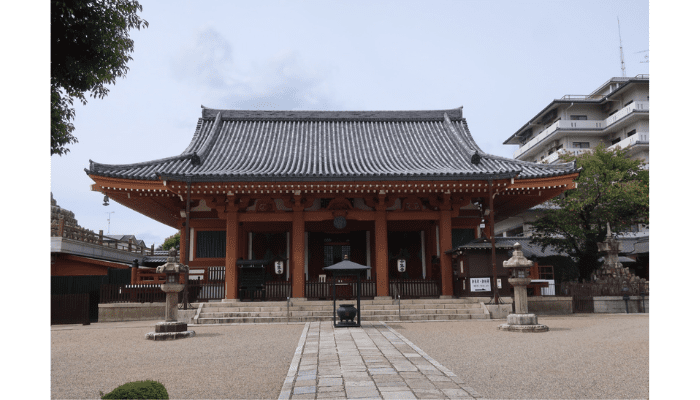
Mibudera Temple, founded in 991, is closely associated with the Shinsengumi, a famous samurai police force formed in 1863. The group was established in the Mibu area, and two key locations from that time—the Yagi Residence and the Maekawa Residence, which served as their headquarters—still stand along Bōjō Street near the temple’s east gate.
The temple grounds played an important role in the Shinsengumi’s history. It is said that they practiced martial arts and even cannon training within the precincts.
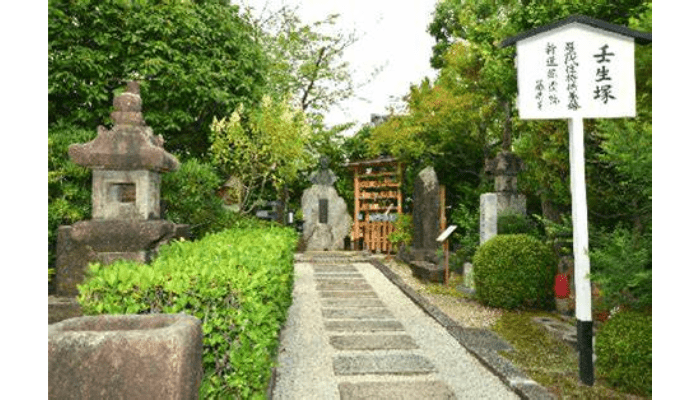
Mibu-zuka: The Shinsengumi Memorial
In the eastern part of the temple grounds lies Mibu-zuka, a memorial site for Shinsengumi members. Here, you can find:
- A statue of Kondō Isami, the Shinsengumi commander.
- A memorial tower containing Kondō’s hair.
- Graves for assassinated members such as Serizawa Kamo and Hirayama Gorō.
- A shared grave for seven other Shinsengumi members.
This area is a must-visit for those interested in samurai history and the Shinsengumi legacy.
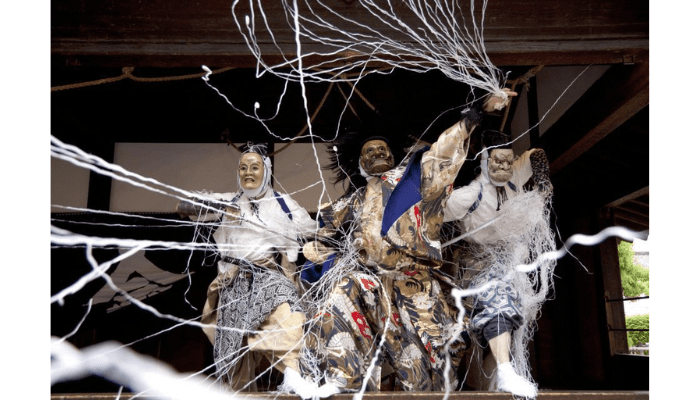
Mibu Kyogen: A Unique Cultural Tradition
Mibudera is also famous for Mibu Kyogen, a traditional form of silent theater cherished by Kyoto locals for centuries. Known affectionately as “Mibu-san no Kanden-den”, this form of entertainment was created over 700 years ago during the Kamakura period by Enkaku Shōnin, a priest who greatly revitalized the temple.
Unlike regular Noh or Kyogen performances, Mibu Kyogen is performed:
- Without dialogue—actors wear masks and rely solely on gestures.
- To the rhythm of traditional instruments like drums, gongs, and flutes.
Despite its entertaining nature, Mibu Kyogen is rooted in religious teachings and retains its original form as a Buddhist-inspired performance. It is staged in the Great Nembutsu Hall, which features unique architectural elements like a second-floor “jumping platform” (tobikomi) and an animal stage (jūdai).
If you’re looking for something a little different, Mibu Kyogen offers a fascinating glimpse into Kyoto’s cultural history.
Visitor Information
- Address: Mibudera Temple, Nakagyō-ku, Kyoto, Bōjō-dōri Bukkoji-kitairu.
- Map: Google Maps
- Access: 5-minute walk from Shijō-Ōmiya Station (Randen).
- Phone: 075-841-3381
- Hours: 8:30 AM–4:30 PM
- Official Website: Mibudera Temple
Arashiyama Station Hannari Hokkori Square
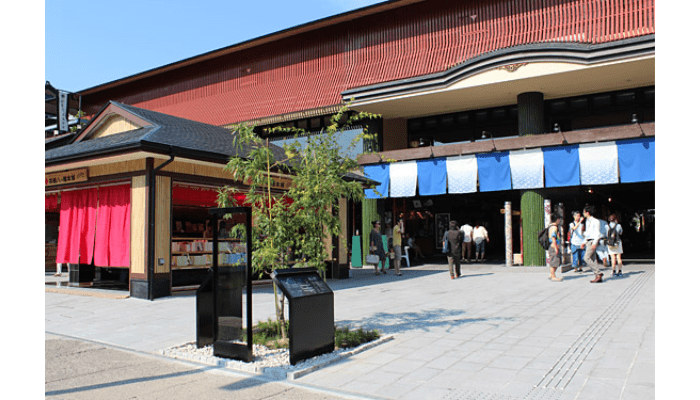
Arashiyama Station Hannari Hokkori Square is a beautifully designed space located at Randen Arashiyama Station, the gateway to Arashiyama. This area blends traditional Kyoto aesthetics with modern design, created by the internationally renowned designer Yasumichi Morita, whose work spans New York, London, Qatar, and Paris.
The square offers a variety of attractions, including shops and restaurants selling sweets, meals, and souvenirs, making it an ideal spot for lunch or souvenir shopping during your visit to Arashiyama.
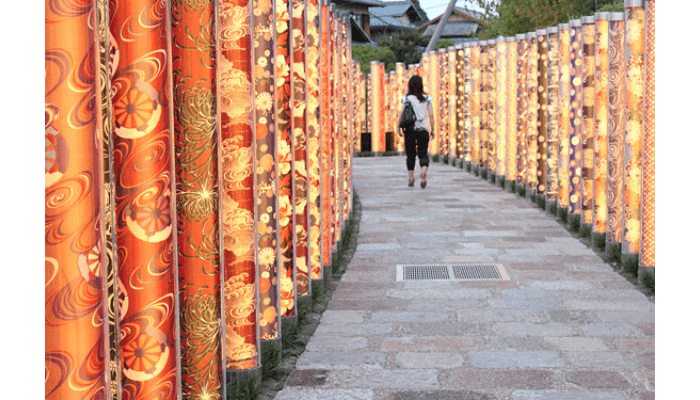
Highlight: The Kimono Forest
The most striking feature of Hannari Hokkori Square is the Kimono Forest, a stunning installation of 600 pillars wrapped in authentic Kyoto yuzen-dyed fabric. These vibrant poles line a pathway known as the “Kimono Lane”, inspired by Arashiyama’s famous Bamboo Grove.
There are 32 unique patterns of yuzen fabric, each carefully selected to showcase the beauty of this traditional craft. The pathway offers a distinct charm, different from the natural beauty of the Bamboo Grove.
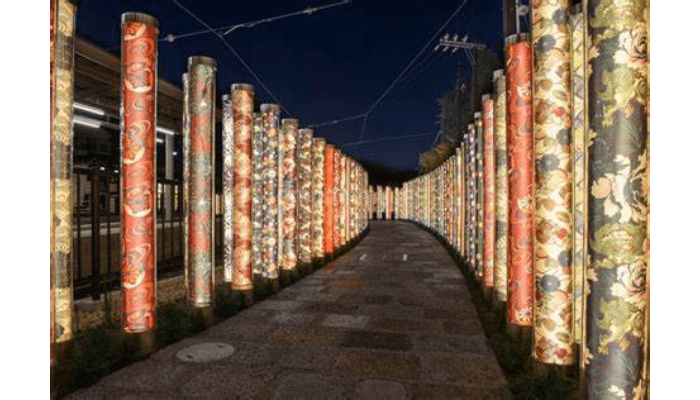
Visit at Night for a Magical Experience
The Kimono Forest is especially enchanting at night when the poles are lit with LED lights. The intricate yuzen patterns glow softly in the darkness, creating a dreamlike atmosphere that feels like stepping into a magical world.
Wearing a kimono and taking photos with the illuminated Kimono Forest has become a popular activity. Don’t miss the chance to capture your perfect shot in this extraordinary setting!
Visitor Information
- Address: 20 Saga-Tenryuji Tsukurimichi-cho, Ukyo-ku, Kyoto
- Map: Google Maps
- Access: Located right at Randen Arashiyama Station
- Phone: 075-801-2511
- Hours: 9:00 AM–8:00 PM
- Official Website: Hannari Hokkori Square
Arashiyama Monkey Park
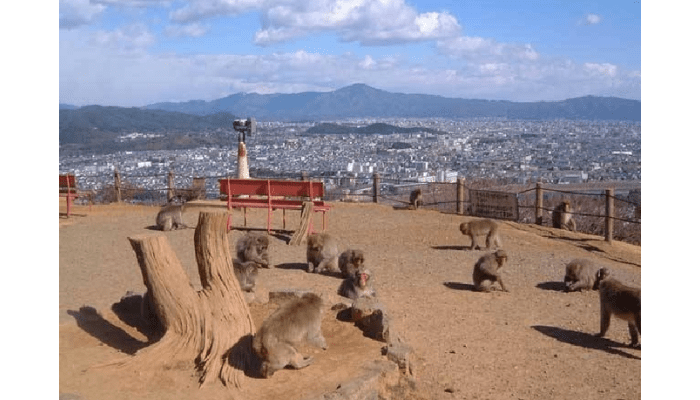
Arashiyama Monkey Park is home to about 120 wild Japanese macaques, living freely in their natural habitat. Visitors can observe these monkeys up close and even feed them safely, making it a highly rated destination for both locals and international tourists.
At the summit of the park, there’s a rest area where you can purchase food like apples and peanuts to feed the monkeys. Feeding is only allowed from inside the rest area, ensuring a safe and enjoyable experience for both visitors and the monkeys.
This unique chance to interact with wild animals, which is rare outside of a zoo, makes the park a special place to visit.

Baby Monkeys in Spring and Summer
From April to July, the park enters its baby season, and you might spot mother monkeys carrying their newborns close to their bellies.
The adorable baby monkeys, with their curious eyes and tiny hands, are sure to bring a smile to your face.
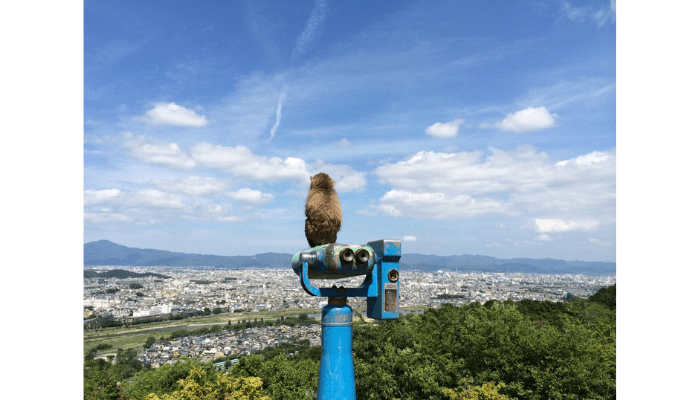
Stunning Views and Seasonal Beauty
Arashiyama Monkey Park isn’t just about the monkeys—it’s also about the breathtaking scenery. The hike from the entrance to the summit takes about 20 minutes, offering stunning views of nature along the way.
Depending on the season, you can enjoy:
- Cherry blossoms in spring
- Lush greenery in summer
- Vibrant autumn leaves in fall
On clear days, you can also enjoy panoramic views of Kyoto, including landmarks like Kyoto Tower.
Visitor Information
- Address: 61 Iwatayama Nakao-cho, Nishikyo-ku, Kyoto
- Map: Google Maps
- Access: A 5-minute walk from Randen Arashiyama Station
- Phone: 075-872-0950
- Hours: 9:00 AM–4:00 PM
- Closed: Open year-round
- Admission: Adults ¥550, Children ¥250
- Official Website: Arashiyama Monkey Park
Here’s a guide to exploring Kyoto’s must-visit spots on the nostalgic Randen (Keifuku Electric Railroad).
If you usually rely on city buses or the Hankyu Railway for your travels, this will surely be a fresh and unique experience.
From cherry blossom views through the train windows to special themed trains, Randen offers a one-of-a-kind way to enjoy Kyoto. Use this guide to discover a new side of Kyoto and make your trip even more memorable!
▼ Related Articles for Kyoto Sightseeing
